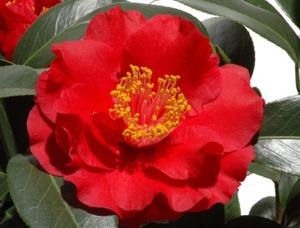Advice for the Home Gardener
From the UC Master Gardener Program
Help Desk of Contra Costa County

The leaning bush has been propped up and the soil tamped down, but I'm concerned about the long term health of these bushes. Can you offer any advice for the eaten roots and over-all care of these bushes? I prefer organic methods, where possible.
Thank you in advance for any assistance you may have available.
Help Desk Response: Thank you for contacting the UC Master Gardener Program Help Desk about the damage to your camellia bush.
Camellias are beautiful evergreen broad-leaved shrubs with fibrous shallow root systems that lie close to the surface of the soil, so immediately identifying and excluding any burrowing pest is critical! Unfortunately, I can't locate any specific information on vertebrate pests that prefer camellias, so you'll need to investigate the potential of a few of our common burrowing and root damaging vertebrate pests. The common pests in our area are ground squirrels, moles, pocket gophers or voles.
- The best way to determine what type of pest you have is by the damage you see:
Ground Squirrels: The key identifier for these rodents is an exposed tunnel entrance with discarded dirt surrounding the entrance of the tunnel. You can see right into a ground squirrel burrow, unlike that of moles or pocket gophers.
Moles: If you have a mole, you will see mounds of dirt and/or surface tunnels. Dirt mounds (look like piles or "puffs" of dirt shaped like a volcano) and surface tunnels (look like the veins on the back of your hand). Not all moles will have both surface tunnels and dirt mounds. If you see one or the other (or both), you have a mole.
Pocket Gophers: Damage done by pocket gophers is similar to moles, but there is a major difference. Dirt mounds are crescent-shaped (like a "C") with a "dirt plug" on one side of the mound.
Voles: Voles typically “piggy back” on the damage done by moles and tend to travel in mole tunnels and often are the cause of damage to roots, bulbs, and tubers within.
Here is a link that includes a good photo of the various types of soil disruption from these pests: https://ucanr.edu/blogs/blogcore/postdetail.cfm?postnum=21028
UC IPM Pest Notes provide specific guidance on identification of these garden pests as well as suggested management strategies to control pests. Here are links to the Pest Notes for the pests listed above that will help you identify the damage they cause and how best to control them:
Ground Squirrels: http://www.ipm.ucdavis.edu/PMG/PESTNOTES/pn7438.html
Moles: http://www.ipm.ucdavis.edu/PMG/PESTNOTES/pn74115.html
Pocket Gophers: http://www.ipm.ucdavis.edu/PMG/PESTNOTES/pn7433.html
Voles: http://www.ipm.ucdavis.edu/PMG/PESTNOTES/pn7439.html
Once the pest is identified and controlled, we suggest that you may want to replant the leaning shrub that has suffered the most root damage. This is a good time to do it as camellias are generally planted in the late fall through the early spring. There is no guarantee that the plant will survive as it will depend on how serious the damage is. If a small portion of the root system is damaged, there is a greater likelihood the plant will survive.
Here are recommended steps to replant camellias from the American Camellia Society:
Dig a hole that is 1 to 2 inches shorter than the length of the root ball, but make the hole 2 feet wider than the width of the camellia bush. This allows adequate space for the roots to branch out but keeps the top of the root ball above the rim of the hole. Gently loosen the soil at the bottom of the hole with a garden claw or hoe.
Place the camellia bush on top of the soil in the hole; the top of the root ball should protrude out of the hole slightly. Backfill with the enriched soil until the root ball is completely covered. Mound the soil over the top of the root ball and press down gently but firmly to stabilize the plant.
- Create a circular ridge or berm of dirt two to three feet away from the bush; press down firmly so the dirt will not easily wash away. This ridge will help contain water.
- Water the soil thoroughly but do not leave the camellia bush standing in water. Keep it watered regularly until the roots are established and the plant shows signs of growth, then soak the plant once a week to encourage deeper root growth, as camellias roots stay toward the surface.
- Mulch around the camellia bush to retain moisture and even out the soil temperature. Mulch also suppresses weeds.
Here are several additional links for information on camellias pests and culture:
http://ipm.ucanr.edu/PMG/GARDEN/PLANTS/camellia.html
https://ucanr.edu/sites/urbanhort/files/80153.pdf
I hope you've found this information helpful. Good luck with your camellias and please let us know if you have further questions.
Help Desk of the UC Master Gardener Program of Contra Costa County (SLH)
Notes: Contra Costa MG's Help Desk is available almost year-round to answer your gardening questions. Except for a few holidays (e.g., last 2 weeks December), we're open every week, Monday through Thursday for walk-ins from 9:00 am to Noon at 2380 Bisso Lane, Concord, CA 94520. We can also be reached via telephone: (925) 608-6683, email: ccmg@ucanr.edu, or on the web at http://ccmg.ucanr.edu/Ask_Us/. MGCC Blogs can be found at http://ccmg.edu/HortCoCo/ You can also subscribe to the Biog.